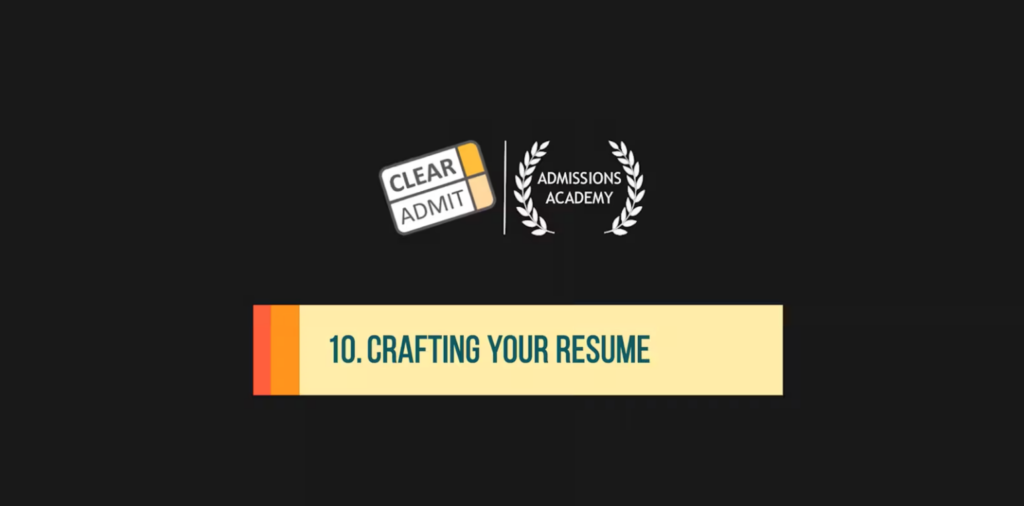Admissions Tip: Writing Your MBA Application Résumé

Your résumé is a key component of your written MBA application – and a great place to start when crafting your overall positioning strategy. The exercise of condensing your entire work and educational history forces you to distill your candidacy into a concise document, focusing on key strengths and themes. This document, combined with a summary of your post-MBA career goals, are cornerstone elements of your application that you’ll want to share with your recommendation writers early in your application process.
With that in mind, here are a few simple tips to get you started:
MBA Résumé Formatting
First things first: because you’re applying to graduate school, you should put your academic history at the top of the document (after your name and contact information, of course). This is also the format that many business schools’ career offices instruct students to use when applying for internships or full-time jobs. In this section, you’ll list degrees, study abroad experience, and relevant non-degree earning coursework.
The next section of your MBA résumé will cover your professional experience. Assuming you can have a few years of full-time experience behind you, you can remove part-time jobs or summer internships that you might have listed previously. Entries in this section should appear in reverse chronological order, i.e. with the most recent at the top.
Most candidates also include a final “Additional Information” section detailing hobbies, interests, and community involvements. We’ll touch on this again later in this article.
Be Kind with Font and Margin Sizing
We’ve been there and we know the temptation: there’s so much you want to say, and you can fit it all if you make your text just a little smaller and your margins a little narrower. Don’t do it! Put yourself in the reader’s shoes. You don’t want to overwhelm them with a page covered in writing, or give them a headache as they strains to read tiny print.
 We recommend that your margins be at least .5″ (ideally wider to create a nice white frame around your copy), and that your text be no smaller than 11pt for serif fonts (like Times New Roman) or 10 pt for sans serif fonts (like Arial).
We recommend that your margins be at least .5″ (ideally wider to create a nice white frame around your copy), and that your text be no smaller than 11pt for serif fonts (like Times New Roman) or 10 pt for sans serif fonts (like Arial).
Remember that your MBA application résumé should reflect the “greatest hits” of your candidacy, not a comprehensive record of every responsibility you’ve held. Drafting this document can be a challenging exercise in editing, but it’s worth it to arrive at a polished product that the admissions reader is happy to receive.
Keep It Simple
While you’ll certainly want to describe your professional responsibilities and achievements in some detail, remember that this document needs to fit on a single page, with very few exceptions. Rather than overwhelming the reader with information, try to identify three or four discrete projects or accomplishments to complement a few concise statements about your day to day responsibilities in each position.
Remember that it’s also important to be as specific as possible about the impact you’ve had on your organization by quantifying the results of your efforts (i.e. writing in terms of percentages and dollar amounts). You should also use active verbs at the outset of each bullet.
Finally, read through and make sure that you remove any industry jargon that someone who works outside of your industry might not readily understand. This is one key way that your MBA application résumé will differ from one you would use to pursue a job in your field. Admissions officers will be making judgments about how clearly you’ll be able to describe your work experience to classmates with diverse professional backgrounds, so take the time to ‘translate’ your résumé into language that anyone could easily grasp.
Round Out Your MBA Resume
Don’t discount the importance of your interests and outside activities – both for your MBA résumé and the business school admissions process. Schools like applicants who are well rounded and demonstrate a track record of involvement outside of work and the classroom, so formal extracurricular activities are a logical category to include. For applicants who are early in their careers, this Additional Information section can be a great place to demonstrate leadership experience.
At the same time, information about your less structured interests and hobbies is also relevant, as these details can lend some more color to your candidacy and help the adcom get to know you better. Remember to be as specific as possible; many business school applicants are interested in “travel” or “film,” so specifying a region you especially enjoy visiting or your favorite movie genre will be the key to setting yourself apart.
We hope that these general guidelines serve as a good starting point MBA applicants in translating their experiences and achievements into this brief but important document. For more guidance, you can also read the Clear Admit Résumé Guide for a complete step-by-step “instruction manual” for crafting your résumé.
